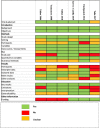18F-FDG /18F-Choline Dual-Tracer PET Behavior and Tumor Differentiation in HepatoCellular Carcinoma. A Systematic Review
- PMID: 35872754
- PMCID: PMC9300997
- DOI: 10.3389/fmed.2022.924824
18F-FDG /18F-Choline Dual-Tracer PET Behavior and Tumor Differentiation in HepatoCellular Carcinoma. A Systematic Review
Abstract
Background: Post-operative recurrence remains the strongest prognostic factor of resected hepatocellular carcinoma (HCC), making the accurate selection of patients with curable HCC a crucial issue. PET imaging combining both 18F-FDG and fatty acid synthase (FAS) radiotracers-such as Choline-has shown its interest for the initial staging and therapeutic management of patients with HCC, but its use is still not consensual. Importantly, the very first dual-tracer PET studies suggested 18F-FDG/FAS PET behavior be linked to the degree of differentiation of HCC, a major predictive factor of post-operative recurrence. Although this key molecular imaging concept may impact how dual-tracer PET will be used in early-stage HCC, its level of evidence remains largely unexplored. In this study, we conducted a systematic review of the available evidence-based data to clarify the relevance of dual 18F-FDG/18F-Choline PET in characterizing the degree of differentiation of HCC tumors.
Methods: A systematic search of the PubMed/Medline and Embase databases was performed up to November 2021. A systematic review of the dual-tracer 18F-FDG/18F-Choline PET behavior of histology-proven HCC according to their degree of differentiation was conducted. The overall quality of the included studies was critically assessed based on the STROBE guidelines. Information on study date, design, patient cohort characteristics, grade of differentiation of HCC tumors, and the dual-tracer PET behavior per HCC was independently extracted and summarized.
Results: From 440 records initially available, 6 full-text articles (99 histology-proven HCC) provided dual-tracer 18F-FDG/18F-Choline PET behavior per HCC tumor grade were included in the systematic review. Based on our analysis, 43/99 HCCs were reported to be well-differentiated, and 56/99 HCCs were reported to be less-differentiated tumors. In the well-differentiated subgroup, more than half were exclusively positive for 18F-Choline (51%), whereas 39% were positive for both 18F-FDG and 18F-Choline. In the less-differentiated subgroup, 37% of HCC patients were positive exclusively for FDG, 36% were positive for both 18F-FDG and 18F-Choline, and 25% were positive exclusively for 18F-Choline.
Conclusion: The 18F-FDG/18F-Choline dual-tracer PET behavior of uptake shows high overlap between well- and less differentiated HCC, making the characterization of tumors challenging based on such PET combination alone. Given our growing knowledge of the molecular complexity of HCC, further studies are necessary to refine our understanding of radiotracers' behavior in this field and improve the usefulness of PET imaging in the clinical decision process of HCC.
Keywords: FDG; HCC; PET; choline; molecular imaging.
Copyright © 2022 Ghidaglia, Golse, Pascale, Sebagh and Besson.
Conflict of interest statement
The authors declare that the research was conducted in the absence of any commercial or financial relationships that could be construed as a potential conflict of interest.
Figures
References
-
- Cucchetti A, Piscaglia F, Caturelli E, Benvegnù L, Vivarelli M, Ercolani G, et al. Comparison of recurrence of hepatocellular carcinoma after resection in patients with cirrhosis to its occurrence in a surveilled cirrhotic population. Ann Surg Oncol. (2009) 16:413–22. 10.1245/s10434-008-0232-4 - DOI - PubMed
Publication types
LinkOut - more resources
Full Text Sources
Research Materials
Miscellaneous



